Here, we talk to Jon Beswick, founder of London-based architecture practice Adventure In Architecture, about the African inspiration for his business, acquiring a Golden Globe-winning client, and the power of word of mouth for marketing.
When did you start the business, why, and what were you doing before this?
From a young age I always wanted my own company, when I was nearing the end of architectural education I worked for as many small companies as I possible to learn as much as I could, what worked and what didn’t. Prior to becoming a fully-qualified architect I embarked on a nine-month expedition down the West Coast of Africa with Charlie Curtis. We drove through 33 countries and covered 30,000 miles through some of the poorest, most remote and turbulent regions in the world including Western Sahara, Sierra Leone,Cote D’Ivoire, Nigeria, Central African Republic, Equatorial Guinea, Gabon, DR Congo, Angola etc. When we returned we decided that nothing could be as hard as the journey we had just overcome and started our own company. Initially I worked for a high-end architectural company in Hampstead part time and wrote about vernacular architecture around the world for Architectural Review until we found our first client. Until I was ARB registered I couldn’t call myself an architect so the first year was extremely tough.
Talk about the early days of the business.
When we first started we tried to keep our overheads as low as possible falling into the trap that many small business fall into by initially working from home. The result is there is no separation between working and resting. I worked every waking hour, was insulated from the property industry, future clients and industry trends and was generally exhausted, not being able to switch off. One of the first big steps was finding an office (which at the time we couldn’t afford) that we shared with another company. This provided a platform for meeting new clients, consultants and property professionals. It encouraged idea sharing, but most importantly provided advice from another small business who had experienced all the problems we were facing. In addition it gave us a fun space to work and grow.
The other early mistake of reducing overheads included hiring junior members of staff and students mid-way through their architectural education who were cheaper to employ. This was a false economy as it meant we had a much higher turnover of staff, who required constant supervision and clients sometimes expressed concern over level of service. One of the recent successes was employing a more senior architect as an office manager. She has streamlined office procedures, manages the staff, wins work and has freed up my time for project winning and business strategy.
3. What was the single ‘turning point’ moment for the business and its revenues?
Ironically the single turning point was an expedition to the South Pole in 2011 for the 100 year anniversary of Captain Scott. This provided me with some press exposure that lead to the redesign of the London residence of James Horner, Golden Globe winner and composer of Titanic. James was a keen pilot and shared a love of adventure which we used the push designs for his apartment by exposing all the services akin to the second world war planes he flew. Photos of the finished apartment lead to other residential projects in London as we’ve grown our portfolio. Six years later, South Pole team member James Balfour teamed up with Bear Grylls and asked us to design their indoor assault courses being rolled out across the country.
4. From that point, how did your business scale? Any other key moments that contributed to success?
Up until recently we have deliberately grown the business organically through word of mouth priding ourself on the level of service we have provided our clients. Over the years we have continued on from the roots of the company foundation planning and delivering expeditions but increasingly for our clients and the consultants we work with. In January this year we rebranded, brought on additional staff and for the first time started actively advertising and marketing the company, formalising a programme of expeditions taking clients on Penny Farthings, sailing on tall ships and climbing mountains. This has resulted in stronger client and team relationships and already we are seeing the benefits the number and quality of projects we are winning.
5. What are your tips to succeeding as a small business?
Most small businesses compete in a sea of similar businesses providing similar pice points similar services. We all think we are better than our competitors but the reality is we probably aren’t much different. From our limited experience we have found that our clients are most responsive if you and your company has a personality or story that they can buy into. People buy into people. Employ great people, deliver a great service at a set price point but in addition provide clients with opportunity or an experience above and beyond your competition.





